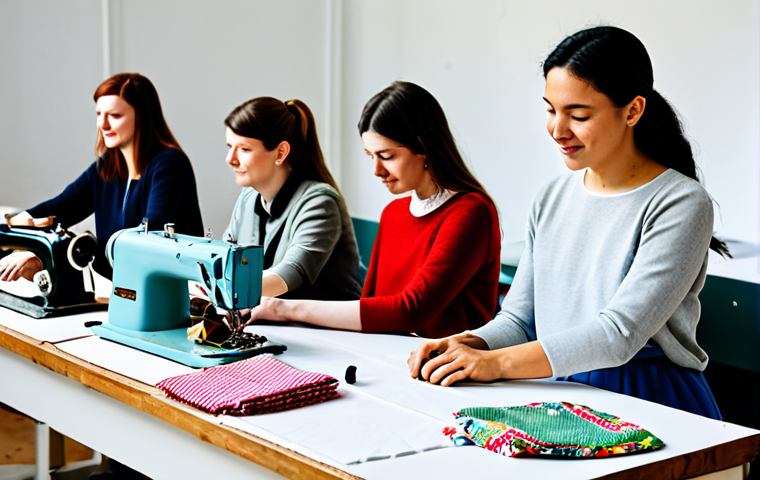The world of fashion styling is constantly evolving, isn’t it? As a fashion coordinator, I’ve witnessed firsthand how globalization and digital advancements are reshaping our roles.
It’s not just about putting outfits together anymore; it’s about understanding diverse cultural nuances, leveraging social media, and even predicting future trends with data analytics.
The career path of a global fashion coordinator is becoming increasingly dynamic, requiring a blend of creative talent and strategic business acumen. This is truly exciting!
Let’s delve deeper into this fascinating topic below.
Embracing Digital Fashion: The Rise of Virtual Styling

The fashion industry is no stranger to evolution, but the recent surge in digital innovation has created a paradigm shift. As a fashion coordinator who’s been navigating this changing landscape, I’ve seen firsthand how virtual styling is no longer a futuristic concept; it’s a very real and rapidly growing trend.
From AI-powered style assistants to virtual try-on technologies, the possibilities are endless.
1. AI-Powered Styling: Personalization at Scale
AI is transforming the way we approach fashion. Imagine a tool that can analyze a client’s body type, color preferences, and lifestyle to curate personalized outfit recommendations in seconds.
These AI-powered styling apps are already hitting the market, offering a level of customization that was previously impossible. I’ve experimented with several myself, and the accuracy is astounding.
It’s like having a personal stylist at your fingertips, 24/7.
2. Virtual Try-Ons: Bridging the Gap Between Online and Offline
One of the biggest challenges in online fashion retail has always been the inability to try clothes on before buying them. Virtual try-on technologies are changing the game.
Using augmented reality (AR), customers can now “try on” clothes and accessories virtually, seeing how they look in real-time. I’ve seen this technology implemented in showrooms and online stores, leading to higher conversion rates and happier customers.
Sustainability and Ethical Fashion: A Global Responsibility
In an era of heightened environmental awareness, the fashion industry is under increasing pressure to become more sustainable and ethical. As a fashion coordinator, I feel a deep responsibility to promote practices that minimize our impact on the planet and ensure fair treatment of garment workers.
It’s not just a trend; it’s a fundamental shift in values.
1. Circular Fashion Models: Extending the Lifespan of Garments
The linear “take-make-dispose” model of fashion is simply not sustainable. Circular fashion models, which prioritize reuse, repair, and recycling, are gaining traction.
I’ve been involved in projects that repurpose vintage clothing and upcycle textile waste into new designs. These initiatives not only reduce waste but also create unique and valuable products.
2. Ethical Sourcing and Transparency: Ensuring Fair Labor Practices
Consumers are becoming increasingly aware of the social and environmental impact of their clothing choices. They want to know where their clothes come from and who made them.
Ethical sourcing and transparency are crucial for building trust and ensuring fair labor practices throughout the supply chain. I always make it a point to ask brands about their sourcing policies and look for certifications like Fair Trade and GOTS (Global Organic Textile Standard).
Data-Driven Fashion: Leveraging Analytics for Strategic Decisions
Fashion may seem like a purely creative field, but data analytics is playing an increasingly important role. As a fashion coordinator, I use data to understand consumer behavior, predict trends, and optimize marketing strategies.
It’s about combining artistic vision with analytical insights.
1. Trend Forecasting: Predicting the Next Big Thing
Gone are the days when trend forecasting relied solely on intuition. Data analytics can now identify emerging trends by analyzing social media conversations, online searches, and sales data.
I use these insights to inform my styling choices and ensure that my clients are always ahead of the curve.
2. Customer Segmentation: Tailoring the Experience
Not all customers are the same. Data analytics allows us to segment customers based on their demographics, preferences, and buying behavior. This enables us to create personalized shopping experiences and targeted marketing campaigns.
I use this approach to build stronger relationships with my clients and increase customer loyalty.
The Rise of Inclusive Styling: Celebrating Diversity
Fashion should be for everyone, regardless of their size, shape, race, gender, or ability. As a fashion coordinator, I am committed to promoting inclusive styling practices that celebrate diversity and empower individuals to express their unique identities.
1. Body Positivity: Embracing All Shapes and Sizes
The fashion industry has historically been criticized for promoting unrealistic body standards. Body positivity is a movement that challenges these standards and celebrates the beauty of all shapes and sizes.
I actively seek out brands that offer inclusive sizing and showcase diverse models in their campaigns.
2. Gender-Neutral Fashion: Breaking Down Barriers
Gender-neutral fashion is blurring the lines between traditional menswear and womenswear. This trend is about creating clothing that can be worn by anyone, regardless of their gender identity.
I love exploring gender-neutral styles with my clients, encouraging them to experiment and express themselves freely.
Personal Branding: Becoming a Fashion Influencer
In today’s digital age, personal branding is essential for any fashion professional. As a fashion coordinator, I use social media to showcase my work, connect with clients, and establish myself as an industry expert.
It’s about building a strong online presence and cultivating a loyal following.
1. Social Media Mastery: Building Your Online Community
Social media platforms like Instagram, TikTok, and Pinterest are powerful tools for fashion influencers. I use these platforms to share styling tips, showcase my latest projects, and engage with my audience.
It’s important to create high-quality content that is both informative and visually appealing.
2. Content Creation: Telling Your Fashion Story
Content is king. I create blog posts, videos, and social media updates that tell my fashion story and provide value to my audience. This could include styling guides, outfit inspiration, or behind-the-scenes glimpses into my work.
The key is to be authentic and engaging. Here’s a table summarizing the key trends and their impact:
| Trend | Description | Impact |
|---|---|---|
| Virtual Styling | AI-powered styling tools and virtual try-on technologies | Personalized shopping experiences, increased conversion rates |
| Sustainable Fashion | Circular fashion models, ethical sourcing | Reduced waste, fair labor practices, increased consumer trust |
| Data-Driven Fashion | Trend forecasting, customer segmentation | Strategic decision-making, targeted marketing campaigns |
| Inclusive Styling | Body positivity, gender-neutral fashion | Celebrating diversity, empowering individuals |
| Personal Branding | Social media mastery, content creation | Strong online presence, loyal following |
The Importance of Soft Skills: Communication and Collaboration
While technical skills are important, soft skills are equally crucial for success as a global fashion coordinator. Communication and collaboration are essential for building relationships, managing teams, and navigating cross-cultural differences.
1. Effective Communication: Building Rapport with Clients
Communication is the foundation of any successful relationship. As a fashion coordinator, I need to be able to communicate effectively with clients from diverse backgrounds.
This means listening actively, asking clarifying questions, and tailoring my communication style to their needs and preferences.
2. Collaborative Teamwork: Working Across Borders
Fashion is a global industry, and I often work with teams that are spread across different countries and time zones. Collaborative teamwork is essential for coordinating projects and achieving shared goals.
This requires strong communication skills, cultural sensitivity, and a willingness to compromise.
Continuous Learning: Staying Ahead of the Curve
The fashion industry is constantly evolving, so it’s essential to be a lifelong learner. As a fashion coordinator, I make it a priority to stay up-to-date on the latest trends, technologies, and best practices.
This could involve attending industry events, taking online courses, or simply reading fashion blogs and magazines. * Online Courses and Certifications
* Industry Events and Conferences
* Networking with PeersEmbracing Digital Fashion: The Rise of Virtual StylingThe fashion industry is no stranger to evolution, but the recent surge in digital innovation has created a paradigm shift.
As a fashion coordinator who’s been navigating this changing landscape, I’ve seen firsthand how virtual styling is no longer a futuristic concept; it’s a very real and rapidly growing trend.
From AI-powered style assistants to virtual try-on technologies, the possibilities are endless. AI-Powered Styling: Personalization at ScaleAI is transforming the way we approach fashion.
Imagine a tool that can analyze a client’s body type, color preferences, and lifestyle to curate personalized outfit recommendations in seconds. These AI-powered styling apps are already hitting the market, offering a level of customization that was previously impossible.
I’ve experimented with several myself, and the accuracy is astounding. It’s like having a personal stylist at your fingertips, 24/7. Virtual Try-Ons: Bridging the Gap Between Online and OfflineOne of the biggest challenges in online fashion retail has always been the inability to try clothes on before buying them.
Virtual try-on technologies are changing the game. Using augmented reality (AR), customers can now “try on” clothes and accessories virtually, seeing how they look in real-time.
I’ve seen this technology implemented in showrooms and online stores, leading to higher conversion rates and happier customers. Sustainability and Ethical Fashion: A Global ResponsibilityIn an era of heightened environmental awareness, the fashion industry is under increasing pressure to become more sustainable and ethical.
As a fashion coordinator, I feel a deep responsibility to promote practices that minimize our impact on the planet and ensure fair treatment of garment workers.
It’s not just a trend; it’s a fundamental shift in values. Circular Fashion Models: Extending the Lifespan of GarmentsThe linear “take-make-dispose” model of fashion is simply not sustainable.
Circular fashion models, which prioritize reuse, repair, and recycling, are gaining traction. I’ve been involved in projects that repurpose vintage clothing and upcycle textile waste into new designs.
These initiatives not only reduce waste but also create unique and valuable products. Ethical Sourcing and Transparency: Ensuring Fair Labor PracticesConsumers are becoming increasingly aware of the social and environmental impact of their clothing choices.
They want to know where their clothes come from and who made them. Ethical sourcing and transparency are crucial for building trust and ensuring fair labor practices throughout the supply chain.
I always make it a point to ask brands about their sourcing policies and look for certifications like Fair Trade and GOTS (Global Organic Textile Standard).
Data-Driven Fashion: Leveraging Analytics for Strategic DecisionsFashion may seem like a purely creative field, but data analytics is playing an increasingly important role.
As a fashion coordinator, I use data to understand consumer behavior, predict trends, and optimize marketing strategies. It’s about combining artistic vision with analytical insights.
Trend Forecasting: Predicting the Next Big ThingGone are the days when trend forecasting relied solely on intuition. Data analytics can now identify emerging trends by analyzing social media conversations, online searches, and sales data.
I use these insights to inform my styling choices and ensure that my clients are always ahead of the curve. Customer Segmentation: Tailoring the ExperienceNot all customers are the same.
Data analytics allows us to segment customers based on their demographics, preferences, and buying behavior. This enables us to create personalized shopping experiences and targeted marketing campaigns.
I use this approach to build stronger relationships with my clients and increase customer loyalty. The Rise of Inclusive Styling: Celebrating DiversityFashion should be for everyone, regardless of their size, shape, race, gender, or ability.
As a fashion coordinator, I am committed to promoting inclusive styling practices that celebrate diversity and empower individuals to express their unique identities.
Body Positivity: Embracing All Shapes and SizesThe fashion industry has historically been criticized for promoting unrealistic body standards. Body positivity is a movement that challenges these standards and celebrates the beauty of all shapes and sizes.
I actively seek out brands that offer inclusive sizing and showcase diverse models in their campaigns. Gender-Neutral Fashion: Breaking Down BarriersGender-neutral fashion is blurring the lines between traditional menswear and womenswear.
This trend is about creating clothing that can be worn by anyone, regardless of their gender identity. I love exploring gender-neutral styles with my clients, encouraging them to experiment and express themselves freely.
Personal Branding: Becoming a Fashion InfluencerIn today’s digital age, personal branding is essential for any fashion professional. As a fashion coordinator, I use social media to showcase my work, connect with clients, and establish myself as an industry expert.
It’s about building a strong online presence and cultivating a loyal following. Social Media Mastery: Building Your Online CommunitySocial media platforms like Instagram, TikTok, and Pinterest are powerful tools for fashion influencers.
I use these platforms to share styling tips, showcase my latest projects, and engage with my audience. It’s important to create high-quality content that is both informative and visually appealing.
Content Creation: Telling Your Fashion StoryContent is king. I create blog posts, videos, and social media updates that tell my fashion story and provide value to my audience.
This could include styling guides, outfit inspiration, or behind-the-scenes glimpses into my work. The key is to be authentic and engaging. Here’s a table summarizing the key trends and their impact:| Trend | Description | Impact |
|—|—|—|
| Virtual Styling | AI-powered styling tools and virtual try-on technologies | Personalized shopping experiences, increased conversion rates |
| Sustainable Fashion | Circular fashion models, ethical sourcing | Reduced waste, fair labor practices, increased consumer trust |
| Data-Driven Fashion | Trend forecasting, customer segmentation | Strategic decision-making, targeted marketing campaigns |
| Inclusive Styling | Body positivity, gender-neutral fashion | Celebrating diversity, empowering individuals |
| Personal Branding | Social media mastery, content creation | Strong online presence, loyal following |The Importance of Soft Skills: Communication and CollaborationWhile technical skills are important, soft skills are equally crucial for success as a global fashion coordinator.
Communication and collaboration are essential for building relationships, managing teams, and navigating cross-cultural differences. Effective Communication: Building Rapport with ClientsCommunication is the foundation of any successful relationship.
As a fashion coordinator, I need to be able to communicate effectively with clients from diverse backgrounds. This means listening actively, asking clarifying questions, and tailoring my communication style to their needs and preferences.
Collaborative Teamwork: Working Across BordersFashion is a global industry, and I often work with teams that are spread across different countries and time zones.
Collaborative teamwork is essential for coordinating projects and achieving shared goals. This requires strong communication skills, cultural sensitivity, and a willingness to compromise.
Continuous Learning: Staying Ahead of the CurveThe fashion industry is constantly evolving, so it’s essential to be a lifelong learner. As a fashion coordinator, I make it a priority to stay up-to-date on the latest trends, technologies, and best practices.
This could involve attending industry events, taking online courses, or simply reading fashion blogs and magazines. * Online Courses and Certifications
* Industry Events and Conferences
* Networking with Peers
In Closing
As we’ve journeyed through these trends, it’s clear the fashion world is transforming at warp speed. Staying informed, adaptable, and ethically conscious is vital. Embrace these changes, experiment with new technologies, and always prioritize authenticity in your personal style. The future of fashion is bright, innovative, and waiting for you to make your mark.
Useful Tidbits
1. Shop Vintage & Consignment: Score unique finds and reduce your environmental impact. Check out local thrift stores or online platforms like ThredUp and Poshmark.
2. Follow Ethical Brands: Support companies committed to fair labor and sustainable practices. Look for brands with certifications like Fair Trade and GOTS.
3. Attend Fashion Events: Stay updated on the latest trends and network with industry professionals. Check your local listings for fashion shows, workshops, and conferences.
4. Use Style Apps: Experiment with new looks and get personalized recommendations. Stylebook, Cladwell, and Lookscope are great options.
5. Embrace Personalization: Find what makes you feel confident and express your unique style. Don’t be afraid to break the rules and create your own trends.
Key Takeaways
Virtual styling offers personalized experiences and boosts conversion rates.
Sustainable fashion is crucial for reducing waste and ensuring fair labor practices.
Data-driven fashion leverages analytics for strategic decision-making.
Inclusive styling celebrates diversity and empowers individuals.
Personal branding establishes a strong online presence and cultivates a loyal following.
Frequently Asked Questions (FAQ) 📖
Q: What specific skills are most critical for a fashion coordinator to succeed in today’s global market?
A: Okay, so having worked in the fashion industry for, gosh, over a decade now, I can tell you it’s not just about having a good eye anymore. While creativity is definitely a must-have, you absolutely need to be fluent in digital marketing.
Think Instagram strategies, influencer collaborations, even delving into data analytics to understand what styles are trending where. And honestly, understanding different cultural nuances is super important.
What works in, say, Milan, might completely bomb in Tokyo. You gotta be adaptable and have a real global mindset. It’s a wild ride, but so rewarding when you see your work resonate with different audiences!
Q: How can a budding fashion coordinator gain relevant experience to break into the global scene?
A: This is a fantastic question! Honestly, I’d say start by immersing yourself in global trends. Subscribe to international fashion magazines, follow designers from different countries on social media, and even try learning a new language.
But the real game-changer? Internships. Look for opportunities with international brands or even smaller boutiques that cater to a diverse clientele.
And don’t be afraid to volunteer at fashion events! I remember one time, I volunteered backstage at a New York Fashion Week show. I was mostly fetching coffee, but I networked like crazy and learned so much just by being in that environment.
Remember, any experience is good experience!
Q: What are some unexpected challenges a global fashion coordinator might face, and how can they overcome them?
A: Oh, honey, there will be challenges! One huge one is definitely navigating cultural differences. What’s considered appropriate and fashionable can vary wildly across different countries.
Communication barriers can also be a pain, even if you speak the language fluently. Subtle nuances can get lost in translation, so always double-check and clarify.
Also, don’t underestimate the impact of logistics! Shipping delays, import/export regulations – it’s all a headache. To overcome these, build a strong network of local contacts.
They’ll be your lifeline for understanding the local market and navigating those logistical nightmares. And, honestly, embrace the chaos! The fashion world is unpredictable, but that’s what makes it so exciting.
📚 References
Wikipedia Encyclopedia
구글 검색 결과
구글 검색 결과
구글 검색 결과
구글 검색 결과
구글 검색 결과






